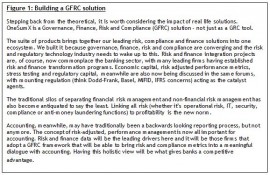Technology is an enabler for stability
A large part of any financial technology businesses is clearly driven by the need for banks to comply with the ever-changing regulatory requirements that affect their business. And this has brought about a frenetic period of activity and growth in this core market. These changes affect the various individual areas within financial organizations Wolters Kluwer Financial Services and others serve, including Finance (e.g. IFRS9), Risk (e.g. Basel III Liquidity, FRTB) and Regulatory Reporting (e.g. CRD IV). They also impact the way in which these processes are governed and controlled centrally, writes Clive Pedder
Moreover, recent changes in forward looking stress testing have required banks, in particular, to focus on achieving a more demonstrably consistent approach to generating and stressing risk and finance projections. These evolving requirements have played to the strengths of our integrated OneSumX Governance, Finance, Risk and Compliance (GFRC) solution, which we brought to market in 2014 – in particular its breadth of capabilities and focus on consistent data and assumptions (see Figure 1: Building a GFRC Solution).
As banks seek to address the evolving needs for greater consistency, governance and control, fintech firms who are employed to implement systems will continue to evolve their solutions to make use of the latest technologies. This is certainly the case if, like us, they are looking for growth. And a helpful way to think about what the opportunities there are is to consider what regulators and investors require from the financial services industry. Arguably, the overall requirements can be summarized in three main areas:
1: Firstly, they need to address the requirements, rules and guidelines they need to comply with. Financial Services organizations, for the large part, operate globally, either directly through overseas branches or indirectly through transactions involving overseas parties and/or instruments. And gathering and interpreting and mapping these to the business is not without effort. Given our global footprint we are certainly well positioned to help here.
2: Secondly, firms need to explore whether they are confident in their ability to adhere to all of these rules, regulations and guidelines. Having mapped these rules to the business management they then need to ensure that they have policies, procedures and systems in place to ensure compliance and manage/mitigate the risks. This will include the “quantitative” requirements, for example the risk calculations. Risk rarely exists in a single silo so the system used to record the above must be capable of providing the multiple linkages between policies, procedures and the rules, regulations and guidelines and with business units and activities. This is where the OneSumX solution can empower institutions in their efforts.
3: Lastly, firms need to show that they can prove the robustness of their risk and regulatory controls to a third party (i.e. regulators, investors, and board members). Wolters Kluwer Financial Services can clearly test that policies and procedures are functioning, providing the expected results. And we can also advise on action plans in the eventuality that they are not functioning as expected. Our solutions share a common data model and platform, assisting the use of a common approach and, importantly, our solutions are always updated in line with changes enabling customers to have access to the latest reports.
 This is all well and good but technology itself poses a risk – especially for systemically important financial institutions (SIFS). And this risk is in the failure of banks to adopt technology that is uniquely designed to meet the very complex needs of financial organizations. A partner that truly knows the financial landscape is absolutely vital – firms that are serious about controlling their GFRC needs can’t just take an out of the box solution and hope for the best.
This is all well and good but technology itself poses a risk – especially for systemically important financial institutions (SIFS). And this risk is in the failure of banks to adopt technology that is uniquely designed to meet the very complex needs of financial organizations. A partner that truly knows the financial landscape is absolutely vital – firms that are serious about controlling their GFRC needs can’t just take an out of the box solution and hope for the best.
The 2007/2008 crisis highlighted the inadequacies in many of the large “too big to fail” banks. Most took days, and some weeks, to be able to establish their true exposure to Lehman Brothers and others. This was because traditionally risk systems were developed in silos and only focused on identifying and managing risks within the silo. Indeed, the intervening years suggest that few SIFS were able to accurately report on their aggregated risk.
If I look at the regulatory response I see two common themes running through the new regulations and guidelines. There is clearly a focus on management being held accountable for the establishing and maintaining strong governance over how their organization functions. And regulations and guidelines now require management to manage, calculate and report on risk at an aggregated level.
As a result, SIFS, in particular, need to invest in technology that will help them manage risk at an enterprise level. The old silos are a thing of the past and they need to think about a holistic GFRC solution. Boards need to know what rules, regulations, codes of conduct and guidelines they need to be complying with, how they are going about it (policies, procedures, systems, culture) and, importantly, actually be able to prove that they are functioning.
Such an approach is vital in an environment where all financial services firms are on a drive for greater efficiency, with a focus on profitability. There is now a desire for a solid Return on Investment (ROI) for all IT projects. While compliance is a necessity, our clients are looking for ways to ensure compliance projects also produce wider business benefits, such as improved efficiency, better control, and an enhanced “bottom line”.
That being said, the rate and number of new and changes to regulations and guidelines is certainly affecting our customers. As most have international operations, they may need to review and interpret hundreds of different rules, regulations and guidelines. These, of course, need to be “mapped” to their businesses and governance procedures established. Occasionally they will be conflicts between local and worldwide requirements that need to addressed.
We are certainly finding that there is strong demand for solutions that can take this unstructured data (rules, regulations and guidelines), turn it into structured data that can then be loaded in to a governance solution.
Clive Pedder is responsible for leading the overall growth strategy of Wolters Kluwer Financial Services’ finance, risk & compliance business across the EMEA region. He has three decades’ experience within the financial technology sector, previously as executive vice president of SunGard’s capital markets business. Prior to this, he was COO of Misys Banking Systems, where he also worked as chief executive of the company’s wholesale banking and asset management businesses.












































